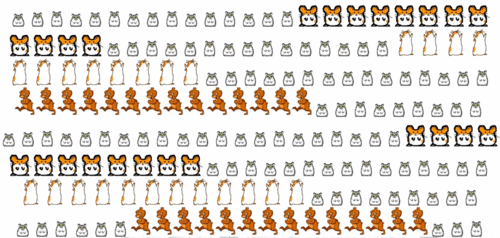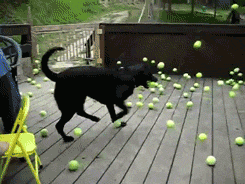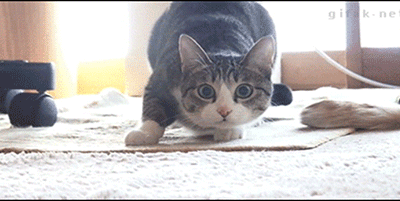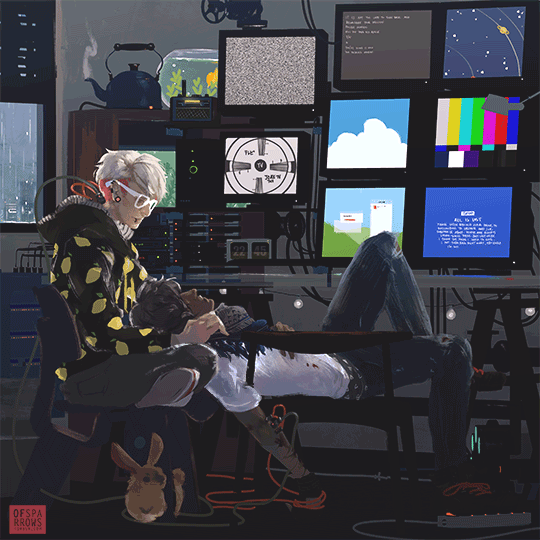Gif About Things Being Good Again
The GIF is officially 30-something, and in the prime of its internet life.
Iii decades ago, on June xv, 1987, the virtually beloved paradigm file extension on the internet was birthed by a squad of CompuServe developers seeking a way to compress images with minimal data loss. The solution: the GIF, a simple, flexible file format for lower-resolution pictures.
My, how far we've come since those inauspicious beginnings. These days, the GIF is so ubiquitous as a piece of cyberspace civilisation that it's got its own offshoot formats like reaction GIFs, GIF art, and Tumblr GIF sets. The question of how to pronounce the word "GIF" has become a rote topic of cultural debate. (The man who invented the GIF, Steve Wilhite, says it with a soft 'Thousand,' like Jif peanut butter, just most people on the internet say it with a hard 'G,' considering a) it's more than fun, b) it avoids confusion with said brand of peanut butter, and c) come on, information technology'south Graphical Interchange Format, not Giraffe-ical Interchange Format.)
On the surface, it might sound strange that a file format that has substantially remained unchanged since the '90s has managed to outlast then many other kinds of college-level internet tech, from Flash animation to early JavaScript. Simply as the blog Enthusiasms notes, "the story of how [the GIF evolved] is actually the story of the internet growing up." Information technology's simultaneously a tale of how the cyberspace'due south design evolution impacted the GIF, and one of how the GIF impacted the net'south design development.
The early days: the internet was under construction, and so was the GIF
Ah, the '90s. The internet was awash in garish designs, thanks to websites with noisy wallpaper backgrounds, Comic Sans font, and the ubiquitous Website Under Construction sign. That Under Construction sign, forth with many other cute, small animated icons, served as the boilerplate man's introduction to the GIF.

Netscape, Marc Andreessen's early web browser, reigned supreme for a hot moment in late 1994 and early on 1995, just before the advent of Cyberspace Explorer (released along with Windows '95) and other competing browsers like Netscape'south eventual successor Firefox. The fate of the GIF was intertwined with Netscape'southward early success.
Netscape was the offset browser to allow the user to interact with an image on a website instead of just text — meaning you could click on an image and have it link you to another webpage or new information. And when Netscape Navigator ii.0 was released in 1995, it supported the .GIF format, including animated GIFs. Thus, if you wanted an easy fashion to decorate your website, GIFs, whether static or animated, were elementary and available.
Plus, when compared to other file formats, these early GIFs took up very little space on your hard drive and required very piffling bandwidth to download.

But even back in the '90s the GIF was already starting to transcend its workhorse origins. Early viral images like the Dancing Baby and meme-ish GIF-based websites like YTMND (Y'all're the Human being At present, Dawg, a reference to a famous early meme) laid the groundwork for the later GIF-splosion. In fact, though the "Baby Cha-Cha," as the boogying infant was known to iii-D modelers, began its life as a video in 1996, it wasn't until developer John Woodell released information technology as a GIF later on that year that its popularity began to spread.
Another early meme was a literal whole page of GIFs — the famous "Hamster Trip the light fantastic" website, created by an fine art student named Deidre LaCarte in 1998.

Early GIFs revealed two crucial things about the format: It was easy to laissez passer around, and no affair how many frames it contained, information technology could be looped an infinite number of times, for an infinite supply of delight.
The middle years: spurred on by everything from Wink to YouTube, the GIF slowly evolves
Every bit web pattern evolved during the early 2000s, the GIF largely cruel out of favor except among meme fans, due to the popular formulation that GIFs were tacky and garish. (At that bespeak in the GIF's history, pop conception wasn't exactly wrong.) The emergence of Flash blitheness, JavaScript, and other more sophisticated tools for transmitting video and images online outstripped the GIF's usefulness.
All the same, the GIF remained a useful way to transmit early memes and replicate Flash-based animation — like the 2001 Dancing Banana from the famous Flash blitheness Peanut Butter Jelly Time.

Throughout the mid-2000s, the concept of "Web 2.0" was the reigning approach to spider web blueprint. Flash was first to stammer under the weight of its ain clunky load time and the public'south dislike of splash pages — those time-consuming, graphics-heavy "front doors" to websites that would take forever to load and which didn't always permit y'all to navigate freely on the respective website. Spider web two.0 coincided with the advent of Google, Wikipedia, and the first social media platforms — MySpace, Facebook, and YouTube, which all debuted between 2003 and 2005. Information technology emphasized less Flash-heavy pattern, amend load times, and more elegant, prettier spider web pages.
Smartphones, like the iPhone prototype that offset appeared in 2005, were start to emerge, and their operating systems and early mobile browsers required more portable, lightweight web pattern and paradigm handling, which would eventually shift the "Spider web 2.0" movement into an emphasis on responsive cross-platform design.
By 2004, all of the existing patents on licensing for the GIF had expired, and the format essentially entered the public domain. The combination of fewer legal restrictions on the GIF and a broader, smartphone-additional demand for a elementary, quick, and more lightweight substitute for Flash animation brought the GIF back in a major way. GIF editing was becoming more than avant-garde thanks to the growing accessibility of editing software similar Photoshop, and people were beginning to convert video into GIF formats in gild to apace present video images.
Meanwhile, the advent of YouTube in 2005 had begun to spur the confluence of meme culture with emerging vlogger culture and celebrity culture, and the GIF was there to capture information technology all. A classic example: 2007'due south "Leave Britney Alone" meme, which gave u.s.a. a famous proto-reaction GIF:

These early video-to-GIF viral memes paved the fashion for the deluge of celebrity reaction GIFs in our future.
The mod era: reaction GIFs explode across the internet — and GIFs become an fine art form unto themselves
And so came the onset of social media, and lo, GIFs were everywhere.
Reddit, Twitter, and Tumblr launched in 2005, 2006, and 2007 respectively, and each of them played major roles in shifting the civilisation of social media toward the use of GIFs — especially the image-friendly Tumblr, where GIFs could exist uploaded in sets of up to x images at once. On Tumblr, GIF sets were oft elaborate, and people used them to tell stories or encapsulate and circulate electric current news.
GIFs could also be hands embedded into the text of Tumblr posts or added to a "reblog" in order to react to an earlier poster's thoughts. And on Reddit, entire subforums arose that were devoted to sharing the perfect reaction GIF or the perfect video moment in GIF form.

Historically, the blithe GIF could be a static paradigm or series of static images looped continuously, looped only once, or looped as many or equally few times as the user desired. While it'due south ever been truthful that GIFs could be looped infinitely or non looped at all, but the modern GIF is more often than not looped infinitely past default. The space loop has become a crucial part of its social function, and advances the GIF's role in assuasive viral videos to spread more easily across the internet in meme form.
And today, it's relatively easy for the boilerplate internet user to screengrab video or still images as GIFS and convert, edit, and add together text and additional imagery to them. At that place are fifty-fifty services that automate the process, allowing GIFs to be more portable and versatile as they travel the web.
Another crucial aspect of the modern GIF is its nature as a quick, all-purpose course of expression. "MFW/TFW" ("My Face up/That Feeling When") and "MRW" ("My Reaction When") have become standard parts of internet lingo that precede the use of a reaction GIF. And while basically any GIF tin be a reaction GIF, some GIFs have become so well known as reaction GIFs that they've essentially entered the cultural dictionary.

Reaction GIFs are so broadly recognized equally fundamental parts of expression on social media that mod social media platforms, from Twitter to Slack, now back up GIF searches through third-party GIF platforms like Giphy and Gfycat. Meanwhile, innumerable smartphone apps support the sending of GIFs through texts.
Finally, the modernistic era of GIFs has too seen the emergence of GIF artists — particularly on Tumblr, where people have fabricated inroads in animated art while forming a complex and unique community. In 2013, Tumblr chose GIF artist and game designer Roger Von Biersborn as its first artist in residence, inviting him to create original art for the site.

At the same time, more retro movements like the Glitch and Vaporwave art movements combine the GIF with the classic pixelation of the early internet to create a unique kind of magic.
Like to the GIF fine art on Tumblr is a course of GIF art called the "Cinemagraph," a popular way of Instagram art begun by photographers Kevin Burg and Jamie Brook which attempts to create loftier-level GIF photography.

The GIF evolution is tied to the future of the internet
In 1987, it'southward highly unlikely that anyone imagined what a wide range and office the GIF would play in mod internet culture. But as the net has evolved, the GIF has shown a surprising power to evolve with it. Information technology'south this immovability, flexibility, and — permit'due south face it — but a touch on of kitsch that has allowed the GIF to go the internet's primary purveyor of memes and looping pictures.
So where will the GIF take us from here? History would suggest that the future of the GIF volition depend on how the cyberspace itself evolves. Notably, Tumblr, Twitter, and Reddit, the current drivers of GIF culture, are all struggling to accomplish sustainability — and as nosotros saw in the example of Vine, some kinds of net fine art can't outlive the death of a platform that birthed the civilization surrounding them.
But the GIF would seem to be here to stay. Technologically speaking, information technology's portable and durable. Perhaps more than importantly, information technology's besides expressive and fun. It has hopped from platform to platform for three decades without stopping, and remained popular in its highest and lowest resolutions, whether animated or cinematic, ironic or sincere.
So GIF on, net. Here's to some other thirty years.
hornlonaddery1983.blogspot.com
Source: https://www.vox.com/culture/2017/6/15/15802136/gif-turns-30-evolution-internet-history
0 Response to "Gif About Things Being Good Again"
Postar um comentário